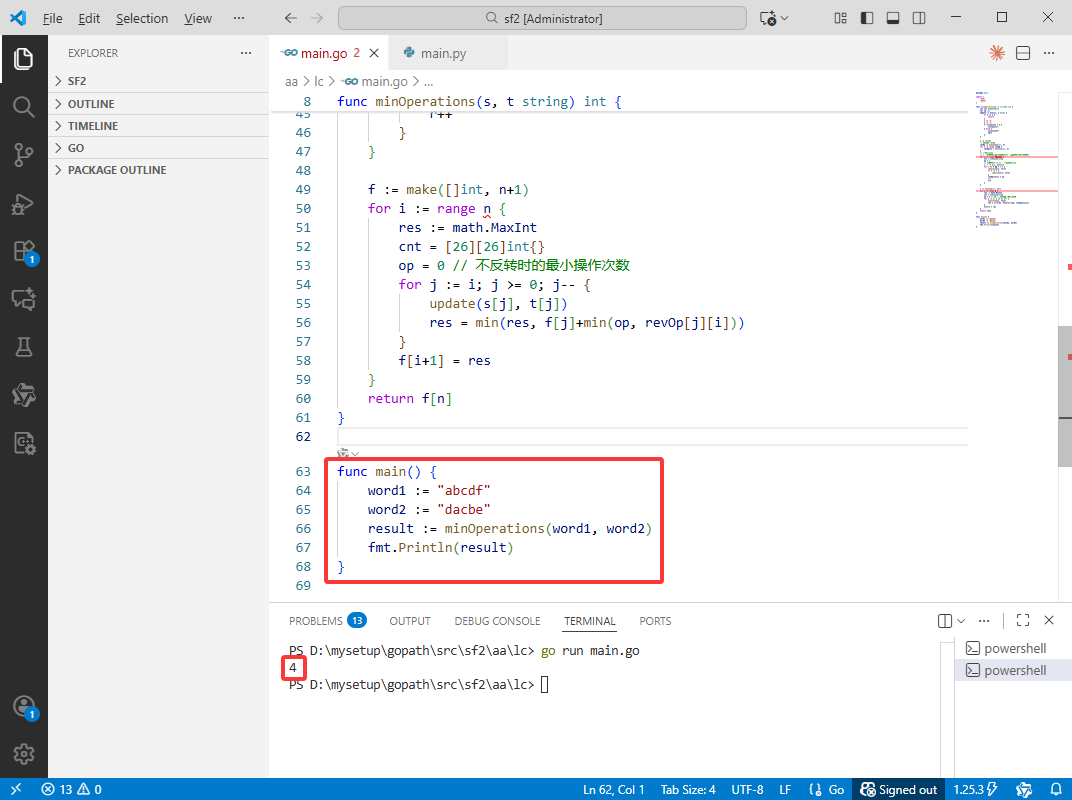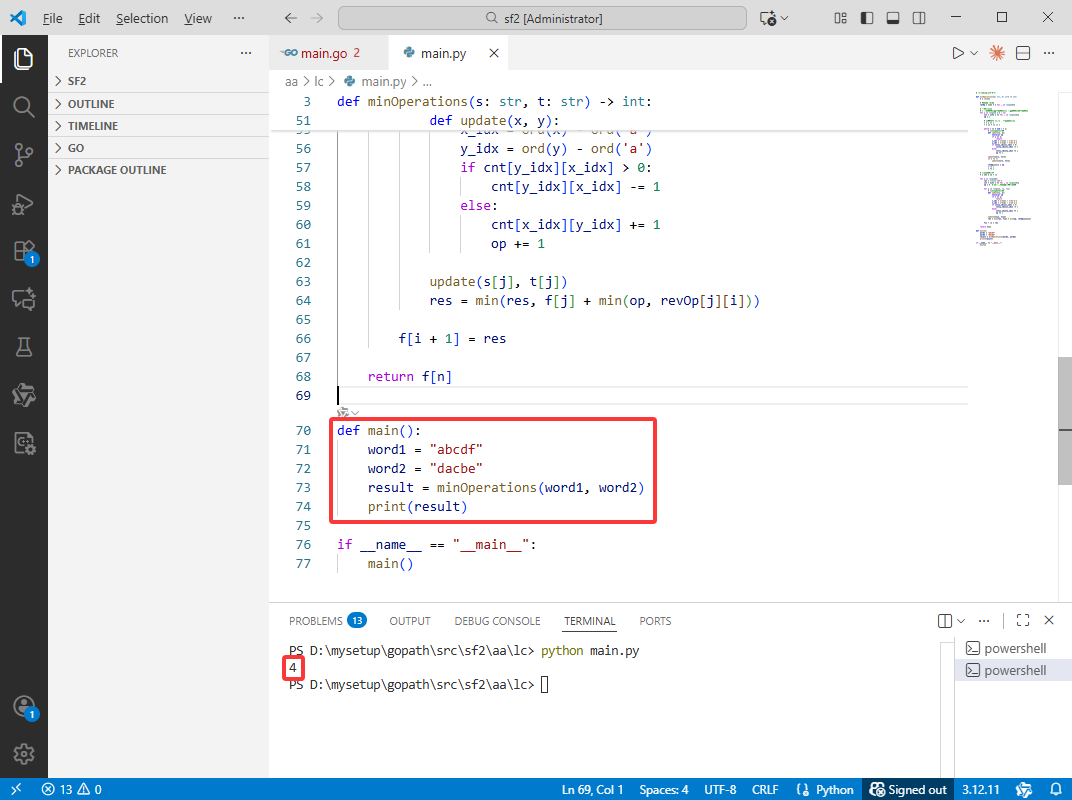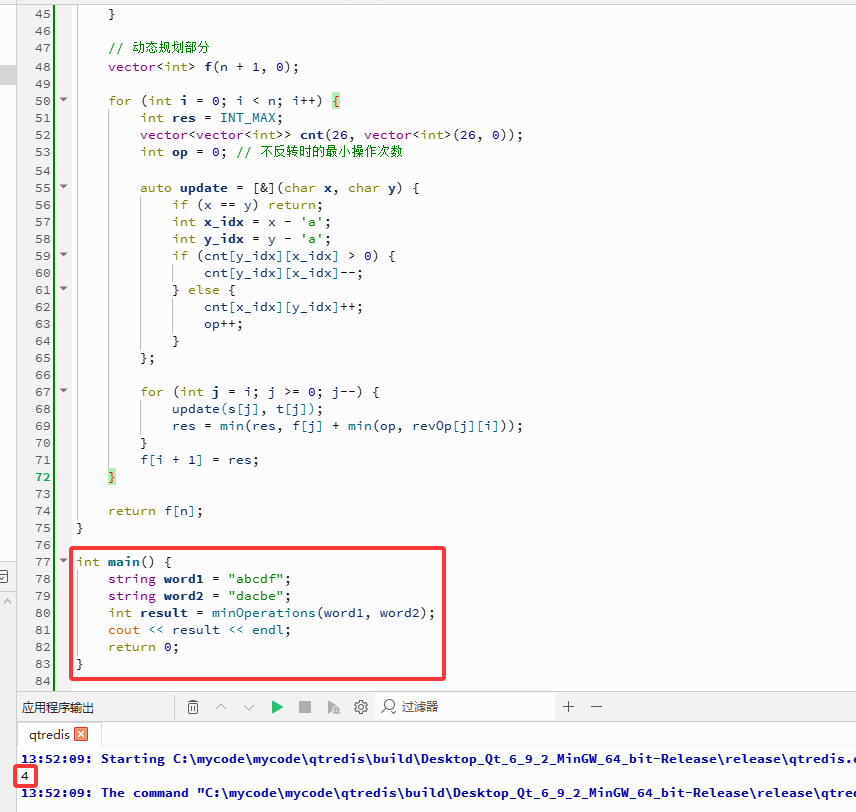2025-11-26:字符串转换需要的最小操作数。用go语言,给定两个等长字符串 word1 和 word2,要求把 word1
2025-11-26:字符串转换需要的最小操作数。用go语言,给定两个等长字符串 word1 和 word2,要求把 word1 变成 word2。
可以先把 word1 分成一个或多个连续片段(子串),然后对这些片段分别进行操作。允许的操作有三种:
-
在某个片段内,把某个位置上的字符改为另一个小写字母(替换)。
-
在片段内交换任意两个字符的位置(交换)。
-
将整个片段的字符顺序倒过来(反转)。
每进行一次上述任一操作都计为一次操作。
此外,每个片段中的任意字符下标最多只能被一次操作所涉及——也就是说,任何字符位置不能被多次用于替换、交换或反转。
子串指的是原字符串中的连续且非空的一段字符。
目标是用尽可能少的操作次数把 word1 变为 word2,返回所需的最小操作数。
1 <= word1.length == word2.length <= 100。
word1 和 word2 仅由小写英文字母组成。
输入: word1 = “abcdf”, word2 = “dacbe”。
输出: 4。
解释:
将 word1 分割为 “ab”、“c” 和 “df”。操作如下:
对于子串 “ab”:
执行类型 3 的操作:“ab” -> “ba”。
执行类型 1 的操作:“ba” -> “da”。
对于子串 “c”:无需操作。
对于子串 “df”:
执行类型 1 的操作:“df” -> “bf”。
执行类型 1 的操作:“bf” -> “be”。
题目来自力扣3579。
分步骤描述
-
初始化与预处理反转操作成本(
revOp数组)- 目的:计算字符串中每个子串通过反转操作(操作类型3)转换为目标子串所需的最小操作数。反转操作允许交换字符位置,其成本取决于字符不匹配的程度。
- 中心扩展法:代码遍历所有可能的子串中心(共
2n-1个,包括字符位置和字符间位置)。对于每个中心点:- 设置左右指针
l和r,分别向左右扩展,形成子串区间[l, r]。 - 在扩展过程中,调用
update函数处理字符对:- 比较
word1[l]与word2[r]以及word1[r]与word2[l](当l ≠ r时),模拟反转操作下的字符映射。 update函数维护一个字符对计数数组cnt(大小 26×26)。如果字符对(x, y)存在相反方向的配对(y, x),则减少操作数(利用交换操作抵消成本);否则增加操作数。
- 比较
- 将当前子串
[l, r]的反转操作数记录到二维数组revOp[l][r]中。
- 设置左右指针
- 作用:预处理后,
revOp[l][r]表示子串word1[l:r+1]反转后匹配word2[l:r+1]的最小操作数。例如,子串 “ab” 反转后变为 “ba”,再通过替换操作匹配目标。
-
动态规划填充
f数组- 目的:计算将
word1的前缀转换为word2前缀的最小操作数,支持字符串分割为连续片段。每个片段可选择直接处理或反转后处理。 - 数组定义:
f[i]表示将word1的前i个字符转换为word2前i个字符的最小操作数(f[0] = 0表示空前缀)。 - 填充过程:
- 遍历每个位置
i(从 0 到n-1),计算f[i+1]。 - 对于每个
i,枚举所有可能的分割点j(从i递减到 0),将子串[j, i]作为一个片段:- 重置
cnt数组和操作计数器op。 - 不反转情况:顺序处理子串
[j, i],调用update函数逐字符比较word1[k]和word2[k](k从j到i),计算通过替换和交换操作的成本op。 - 反转情况:直接使用预处理的
revOp[j][i]作为该片段的反转操作成本。 - 取两种情况的最小值:
min(op, revOp[j][i])。 - 更新
f[i+1] = min(f[i+1], f[j] + min_value),即前j个字符的成本加上当前片段的成本。
- 重置
- 遍历每个位置
- 示例:对于输入
word1 = "abcdf",word2 = "dacbe",分割为"ab"、"c"、"df":- 片段
"ab":反转操作成本revOp[0][1] = 2(先反转为 “ba”,再替换为 “da”)。 - 片段
"c":无需操作(字符匹配)。 - 片段
"df":直接操作成本op = 2(两次替换)。 - 总操作数
f[5] = f[2] + 2 + f[3] + 0 + f[5] + 2 = 4。
- 片段
- 目的:计算将
-
结果提取
- 动态规划完成后,
f[n]即为整个字符串转换的最小操作数。代码返回f[n]作为结果。
- 动态规划完成后,
时间复杂度和空间复杂度
-
时间复杂度:
- 预处理
revOp数组使用中心扩展法,共有O(n)个中心,每个中心扩展最多O(n)次,每次扩展调用O(1)的update函数,因此预处理阶段复杂度为 O(n²)。 - 动态规划阶段:外层循环遍历
n个位置,内层循环对于每个i枚举j从i到 0,且每个j需要处理长度为O(i-j)的子串(通过update函数)。内层循环的总代价为O(i²),因此整体复杂度为 O(n³)(因为∑i²从 0 到 n-1 是 O(n³))。 - 总时间复杂度:O(n³),由于
n ≤ 100,实际计算可行。
- 预处理
-
额外空间复杂度:
revOp数组大小为n × n,占用 O(n²) 空间。- 动态规划数组
f大小为n+1,占用 O(n) 空间。 - 字符对计数数组
cnt大小为 26×26,为常数空间 O(1)。 - 总空间复杂度:O(n²),主要由
revOp数组决定。
Go完整代码如下:
package main
import (
"fmt"
"math"
)
func minOperations(s, t string) int {
var cnt [26][26]int
var op int
update := func(x, y byte) {
if x == y {
return
}
x -= 'a'
y -= 'a'
if cnt[y][x] > 0 {
cnt[y][x]--
} else {
cnt[x][y]++
op++
}
}
n := len(s)
// 预处理 revOp
revOp := make([][]int, n)
for i := range revOp {
revOp[i] = make([]int, n)
}
// 中心扩展法
// i 为偶数表示奇长度子串,i 为奇数表示偶长度子串
for i := range 2*n - 1 {
cnt = [26][26]int{}
op = 1
// 从闭区间 [l,r] 开始向左右扩展
l, r := i/2, (i+1)/2
for l >= 0 && r < n {
update(s[l], t[r])
if l != r {
update(s[r], t[l])
}
revOp[l][r] = op
l--
r++
}
}
f := make([]int, n+1)
for i := range n {
res := math.MaxInt
cnt = [26][26]int{}
op = 0 // 不反转时的最小操作次数
for j := i; j >= 0; j-- {
update(s[j], t[j])
res = min(res, f[j]+min(op, revOp[j][i]))
}
f[i+1] = res
}
return f[n]
}
func main() {
word1 := "abcdf"
word2 := "dacbe"
result := minOperations(word1, word2)
fmt.Println(result)
}

Python完整代码如下:
# -*-coding:utf-8-*-
def minOperations(s: str, t: str) -> int:
n = len(s)
# 预处理 revOp
revOp = [[0] * n for _ in range(n)]
# 中心扩展法
# i 为偶数表示奇长度子串,i 为奇数表示偶长度子串
for i in range(2 * n - 1):
cnt = [[0] * 26 for _ in range(26)]
op = 1
# 从闭区间 [l,r] 开始向左右扩展
l = i // 2
r = (i + 1) // 2
while l >= 0 and r < n:
# 定义update函数
def update(x, y):
nonlocal op
if x == y:
return
x_idx = ord(x) - ord('a')
y_idx = ord(y) - ord('a')
if cnt[y_idx][x_idx] > 0:
cnt[y_idx][x_idx] -= 1
else:
cnt[x_idx][y_idx] += 1
op += 1
update(s[l], t[r])
if l != r:
update(s[r], t[l])
revOp[l][r] = op
l -= 1
r += 1
# 动态规划部分
f = [0] * (n + 1)
for i in range(n):
res = float('inf')
cnt = [[0] * 26 for _ in range(26)]
op = 0 # 不反转时的最小操作次数
for j in range(i, -1, -1):
# 定义update函数
def update(x, y):
nonlocal op
if x == y:
return
x_idx = ord(x) - ord('a')
y_idx = ord(y) - ord('a')
if cnt[y_idx][x_idx] > 0:
cnt[y_idx][x_idx] -= 1
else:
cnt[x_idx][y_idx] += 1
op += 1
update(s[j], t[j])
res = min(res, f[j] + min(op, revOp[j][i]))
f[i + 1] = res
return f[n]
def main():
word1 = "abcdf"
word2 = "dacbe"
result = minOperations(word1, word2)
print(result)
if __name__ == "__main__":
main()

C++完整代码如下:
#include <iostream>
#include <vector>
#include <string>
#include <climits>
#include <algorithm>
using namespace std;
int minOperations(string s, string t) {
int n = s.length();
// 预处理 revOp
vector<vector<int>> revOp(n, vector<int>(n, 0));
// 中心扩展法
for (int i = 0; i < 2 * n - 1; i++) {
vector<vector<int>> cnt(26, vector<int>(26, 0));
int op = 1;
// 从闭区间 [l,r] 开始向左右扩展
int l = i / 2;
int r = (i + 1) / 2;
auto update = [&](char x, char y) {
if (x == y) return;
int x_idx = x - 'a';
int y_idx = y - 'a';
if (cnt[y_idx][x_idx] > 0) {
cnt[y_idx][x_idx]--;
} else {
cnt[x_idx][y_idx]++;
op++;
}
};
while (l >= 0 && r < n) {
update(s[l], t[r]);
if (l != r) {
update(s[r], t[l]);
}
revOp[l][r] = op;
l--;
r++;
}
}
// 动态规划部分
vector<int> f(n + 1, 0);
for (int i = 0; i < n; i++) {
int res = INT_MAX;
vector<vector<int>> cnt(26, vector<int>(26, 0));
int op = 0; // 不反转时的最小操作次数
auto update = [&](char x, char y) {
if (x == y) return;
int x_idx = x - 'a';
int y_idx = y - 'a';
if (cnt[y_idx][x_idx] > 0) {
cnt[y_idx][x_idx]--;
} else {
cnt[x_idx][y_idx]++;
op++;
}
};
for (int j = i; j >= 0; j--) {
update(s[j], t[j]);
res = min(res, f[j] + min(op, revOp[j][i]));
}
f[i + 1] = res;
}
return f[n];
}
int main() {
string word1 = "abcdf";
string word2 = "dacbe";
int result = minOperations(word1, word2);
cout << result << endl;
return 0;
}

- 点赞
- 收藏
- 关注作者


评论(0)